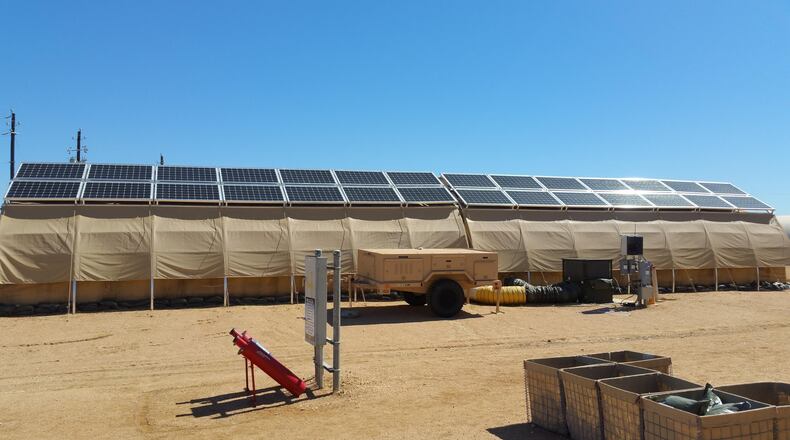“This is recognition of exceptional contributions and accomplishment,” said Maj. Gen. William T. Cooley, AFRL commander, in a note to the staff. “Congratulations, and thanks for all you do for the AFRL and Air Force mission.”
The AFRL Energy and Environment Team stood out for their efforts in executing a $157 million budget dedicated to improving energy and weapons efficiency and reducing environmental impacts and pollution for the Air Force.
The 21-member team, based out of the AFRL Materials and Manufacturing Directorate, drove the work of more than 200 government and contractor personnel to address over 80 Congressional special interest items. The team included members from the directorate finance team, contracting unit and Acquisition Systems Support Branch, which manages the Advanced Power Technology Office for the Air Force.
Impacting areas such as waste-to-energy conversion systems, flexible armor, next-generation carbon-fiber C-5 inlet replacements, and clean solutions for remote radar power generation for early warning radar systems, the challenge of managing such large and diverse projects across the U.S. is of no small feat. The team’s leadership expertise is shown through work with program offices, project partners and industry in diverse locations across the U.S. to execute the Air Force energy mission.
“One of our biggest impacts was promoting awareness of advanced power and alternative energy technologies in the Air Force,” said Capt. Randall J. Hodkin Jr., the Aviation Working Group Lead for APTO. “There is potential for the Air Force to save millions of dollars in energy costs by smartly implementing these kinds of technologies, and making the right people aware of that potential is a critical first step in moving toward putting these solutions to work in the field.”
For a recent project in Kotzebue, Alaska, the team collaborated with the Pacific Air Forces Regional Support Center and 611th Civil Engineer Squadron to demonstrate energy-harvesting wind turbines to offset the energy costs in this austere region, which can experience temperatures below -40 degree Fahrenheit. In conjunction with this project, the team is exploring rapidly-deployable solar panels on Mt. Koke’e, Hawaii, with a novel, lightweight durable design with significant potential for Air Force field applications.
The team’s oversight of the Air Force’s cutting-edge, Forward Operating Base of the Future received high acclaim from former Secretary of the Air Force Deborah Lee James, who praised the team’s efforts in helping to ensure the Air Force is able to execute missions through renewable and advanced energy technologies when traditional systems are disrupted.
Located at the Basic Expeditionary Airmen Skills Training facility in San Antonio, Texas, the innovative project exemplifies the team’s energy mission by focusing on alternative energy sources such as smart controllers, microgrids, advanced batteries, solar cells and more to ensure operational energy sources exist to power the Air Force global mission.
“This team made a huge impact on the Air Force drive to cut energy costs, reduce environmental impacts and make weapon systems more efficient. We are extremely proud that they were recognized for their extraordinary work,” said Col. Charles Ormsby, acting director, Materials and Manufacturing Directorate. “We cultivate and grow leaders here, and this is another fine demonstration of a Materials and Manufacturing team leading innovation in acquisition and technology for the Air Force.”
Members of the Energy and Environment Team include Charlotte M. Chumack, Timothy R. Kramer, Robert D. Lorton, Mark L. Merrifield, Mary Ann Sharits and Amanda Smith from the AFRL Contracting unit; Susan E. Moulton and Stella A. Speranza from the Materials and Manufacturing Directorate Finance Office; and the following members from the Materials and Manufacturing Directorate’s Acquisition Systems Support Branch: Warren J. Assink, Maj. Benjamin M. Bennett, 2nd Lt. Matthew C. Couch, Lt. Col. Scott V. Fitzner, Capt. Jason A. Goins, Capt. Harold J. Gotwald, Eric W. Griesenbrock, Capt. Randall J. Hodkin, Thomas R. Layne, David S. Madden, Maj. Matthew J. Quinton, Kevin R. Spitzer and James G. Vital.
About the Author
